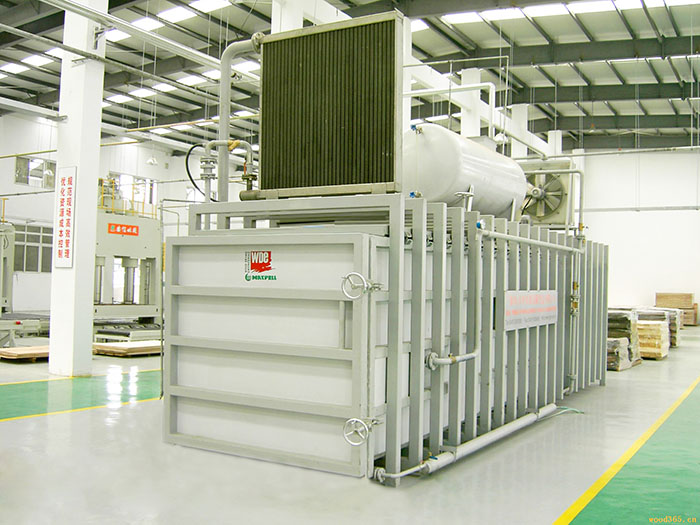干燥设备
干燥设备又称干燥器和干燥机。用于进行干燥操作的设备,通过加热使物料中的湿分(一般指水分或其他可挥发性液体成分)汽化逸出,以获得规定含湿量的固体物料。干燥的目的是为了物料使用或进一步加工的需要。如木材在制作木模、木器前的干燥可以防止制品变形,陶瓷坯料在煅烧前的干燥可以防止成品龟裂。另外干燥后的物料也便于运输和贮存,如将收获的粮食干燥到一定湿含量以下,以防霉变。由于自然干燥远不能满足生产发展的需要,各种机械化干燥器越来越广泛地得到应用。
去湿的方法按作用原理可以分为机械法、热物理法和物理化学法三种。一般情况下热物理法去湿称为干燥, 干燥就是利用热能使湿物料中的湿分 (水分或其他溶剂) 汽化, 水汽或蒸汽经气流带走或由真空泵将其抽出除去, 而获得固体产品的操作过程。对湿物料进行干燥时, 有两种干燥过程, 一种是表面汽化过程, 热量从周围环境传递至物料表面, 使表面湿分蒸发另一种是内部扩散控制过程, 物料内部湿分传递到物料表面, 然后再蒸发。物料的干燥速率由上述两个过程中速率较慢的一个控制。
通过物料干燥特性试验可知, 物料干燥过程可以分为三个阶段。第一阶段为物料预热阶段, 在此期间主要是对湿物料进行预热, 同时也有少量湿分汽化, 物料的温度很快升到近似等于湿球温度;第二阶段为恒速干燥阶段, 此阶段主要特征是热空气传给物料的热量全部用来汽化湿分, 物料表面温度一直保持不变, 湿分则按一定速率汽化;第三阶段为降速干燥阶段, 此时物料的干燥速率由内部扩散过程控制, 热空气所提供的热量只有一小部分用来汽化湿分, 而大部分则用来加热物料, 使物料表面温度上升, 但是干燥速率则逐步降低, 直至达到平衡含湿量为止。
随着工农业的迅猛发展, 干燥设备工业正不断成熟和壮大, 成为机械工业中一个具有蓬勃生机的新兴行业。需进行干燥的既有数千万吨的大批量物料, 也有年产仅几十公斤的贵重物品;因而既有一些大型干燥设备以适应独特的工艺要求和生产能力, 又有一些中小型通用干燥设备。干燥设备广泛应用于化工、建材、食品、药物及生化等行业。
干燥设备分类:
干燥设备的种类繁多, 根据操作压力、操作方式、传热原理、加热方式、构造等的不同可以将干燥设备归于不同的类别。按操作压力可以分为常压式和真空式两类;按操作方式可分为间歇操作和连续操作两类;按传热原理可分为传导加热式、对流加热式、辐射传热式和高频加热式等几类;按加热方式可分为直接加热式和间接加热式两类;按构造可以分为喷雾干燥器、流化床干燥器、气流干燥器、桨式干燥器、箱式干燥器及旋转闪蒸干燥器等。
干燥设备应用行业:
石油及化学工业:聚合、缩合、蒸馏、熔融、脱水、强制保温。
油脂工业:脂肪酸蒸馏、油脂分解、浓缩、酯化、真空脱臭。
合成纤维工业:聚合、熔融、纺丝、延伸、干燥。
纺织印染工作:热定型、烘干、热容染色。
非织造工业:无纺布。
饲料工业:烘干。
塑料及橡胶工业:热压、压延、挤压、硫化成型。
造纸工业:干燥、波纹纸加工。
木材工业:多合板、纤维板加压成型、木材干燥。
建材工作:石膏板烘干、沥青加热、混凝土构件养护。
机械工业:喷漆、印花烘干。
食品工业:烘烤、加热。
空调工业:工业厂房及民用建筑采暖。
筑路工业:沥青熔化、保温。
制药工业:烘干。
轻工业:生产油墨、洗衣粉。
Drying equipment is also known as dryers and dryers. A device for performing a drying operation by vaporizing a moisture component (generally referred to as moisture or other volatile liquid component) in a material to obtain a solid material having a prescribed moisture content. The purpose of drying is for the purpose of material use or further processing. For example, the drying of the wood before the production of the wood mold and the wood can prevent the deformation of the product, and the drying of the ceramic material before the calcination can prevent the product from cracking. In addition, the dried material is also convenient for transportation and storage, such as drying the harvested food to a certain moisture content to prevent mildew. Since natural drying is far from meeting the needs of production development, various mechanized dryers are becoming more and more widely used.
The method of dehumidification can be divided into mechanical method, thermophysical method and physical chemistry method according to the principle of action. In general, thermophysical dehumidification is called drying. Drying is the use of heat to vaporize moisture (moisture or other solvent) in wet materials. Water vapor or steam is taken away by airflow or removed by a vacuum pump to obtain a solid product. Operation process. When drying wet materials, there are two drying processes, one is surface vaporization process, heat is transferred from the surrounding environment to the surface of the material, so that the surface moisture is evaporated. The other is internal diffusion control process, and the internal moisture content of the material is transferred to the material. Surface, then evaporate. The drying rate of the material is controlled by one of the slower rates in the two processes described above.
The material drying process can be divided into three stages by the material drying characteristic test. The first stage is the material preheating stage. During this period, the wet material is preheated, and a small amount of moisture is vaporized. The temperature of the material quickly rises to approximately equal to the wet bulb temperature; the second stage is the constant speed drying stage. The main feature of this stage is that the heat transferred from the hot air to the material is used to vaporize the moisture, the surface temperature of the material remains unchanged, and the moisture is vaporized at a certain rate; the third stage is the slow drying stage, at which time the drying rate of the material Controlled by the internal diffusion process, only a small portion of the heat supplied by the hot air is used to vaporize the moisture, while most of it is used to heat the material, causing the surface temperature of the material to rise, but the drying rate is gradually reduced until the equilibrium moisture content is reached. until.
With the rapid development of industry and agriculture, the drying equipment industry is constantly maturing and expanding, becoming an emerging industry in the machinery industry with vitality. There are tens of millions of tons of large-volume materials that need to be dried, as well as valuables with an annual output of only a few tens of kilograms; therefore, there are some large-scale drying equipment to adapt to unique process requirements and production capacity, and some small and medium-sized general drying. device. Drying equipment is widely used in chemical, building materials, food, pharmaceutical and biochemical industries.
Drying equipment classification:
There are many types of drying equipment, and the drying equipment can be classified into different categories depending on the operating pressure, operation mode, heat transfer principle, heating method, structure, and the like. According to the operating pressure, it can be divided into two types: atmospheric pressure type and vacuum type; according to the operation mode, it can be divided into two types: intermittent operation and continuous operation; according to the heat transfer principle, it can be divided into conduction heating type, convection heating type, radiation heat transfer type and high. Frequency heating type, etc.; according to the heating method can be divided into direct heating type and indirect heating type; according to the structure can be divided into spray dryer, fluidized bed dryer, airflow dryer, paddle dryer, box drying And rotary flash dryers, etc.
Drying equipment application industry:
Petroleum and chemical industries: polymerization, condensation, distillation, melting, dehydration, forced insulation.
Oil industry: fatty acid distillation, oil decomposition, concentration, esterification, vacuum deodorization.
Synthetic fiber industry: polymerization, melting, spinning, stretching, drying.
Textile printing and dyeing work: heat setting, drying, heat capacity dyeing.
Non-woven industry: non-woven fabrics.
Feed industry: drying.
Plastics and rubber industry: hot pressing, calendering, extrusion, vulcanization molding.
Paper industry: Dry, corrugated paper processing.
Wood industry: plywood, fiberboard compression molding, wood drying.
Building materials work: gypsum board drying, asphalt heating, concrete component maintenance.
Machinery industry: painting, printing and drying.
Food industry: baking, heating.
Air-conditioning industry: industrial plants and civil buildings for heating.
Road construction industry: asphalt melting, insulation.
Pharmaceutical industry: drying.
Light industry: production of ink, washing powder.

在干燥设备中多使用蒸汽来作为干燥源,阀门多采用来控制蒸汽的流量、压力和温度的阀门,如 电动单座调节阀,电动套筒调节阀,电动三通调节阀,气动单座调节阀,气动套筒调节阀,气动三通调节阀,手动调节阀,法兰闸阀,法兰截止阀,过滤器,安全阀等阀门设备
Steam is used as a drying source in drying equipment. Valves are used to control the flow, pressure and temperature of steam, such as electric single seat control valve, electric sleeve control valve, electric three-way control valve, pneumatic single seat adjustment. Valve, pneumatic sleeve regulating valve, pneumatic three-way regulating valve, manual regulating valve, flange gate valve, flange stop valve, filter, safety valve and other valve equipment

